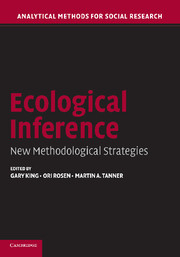Book contents
- Frontmatter
- Contents
- Contributors
- Preface
- INTRODUCTION
- PART ONE
- PART TWO
- 4 Extending King's Ecological Inference Model to Multiple Elections Using Markov Chain Monte Carlo
- 5 Ecological Regression and Ecological Inference
- 6 Using Prior Information to Aid Ecological Inference: A Bayesian Approach
- 7 An Information Theoretic Approach to Ecological Estimation and Inference
- 8 Ecological Panel Inference from Repeated Cross Sections
- PART THREE
- PART FOUR
- Index
5 - Ecological Regression and Ecological Inference
Published online by Cambridge University Press: 18 May 2010
- Frontmatter
- Contents
- Contributors
- Preface
- INTRODUCTION
- PART ONE
- PART TWO
- 4 Extending King's Ecological Inference Model to Multiple Elections Using Markov Chain Monte Carlo
- 5 Ecological Regression and Ecological Inference
- 6 Using Prior Information to Aid Ecological Inference: A Bayesian Approach
- 7 An Information Theoretic Approach to Ecological Estimation and Inference
- 8 Ecological Panel Inference from Repeated Cross Sections
- PART THREE
- PART FOUR
- Index
Summary
ABSTRACT
We propose three methods of ecological inference that guarantee feasible solutions but are simpler to implement than the method of King (1997). Each procedure provides estimates at the level of the ecological unit as well as a more aggregated level. The first method uses a simple squared distance minimization algorithm on the tomographic line segments. The second also generates a distance minimization, but in a space keyed to the slopes and intercepts of possible regression lines. The third determines the regression line that minimizes the sum of the areas between it and pairs of constraint line segments that are generated by a variant of the Duncan–Davis method of bounds. The procedures are implemented on an Excel spreadsheet and are available over the Internet. We present empirical applications, for which the first and third methods yield results that are quite similar to those produced by King's algorithm.
INTRODUCTION
In ecological inference we seek to make use of data that is aggregated at the level of ecological units to make inferences about the behavior of individuals. The ecological fallacy (Robinson, 1950) occurs when relationships between variables that obtain at the aggregate level are not found at the individual level. In this chapter three methods of ecological inference are proposed that are simpler than the sophisticated statistical models offered by King and his colleagues.
- Type
- Chapter
- Information
- Ecological InferenceNew Methodological Strategies, pp. 123 - 143Publisher: Cambridge University PressPrint publication year: 2004
- 7
- Cited by



